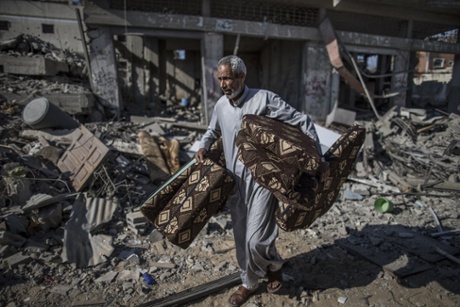Life under fire in Gaza: the diary of a Palestinian
What's it like for families struggling to survive in Gaza? A Palestinian author describes the overcrowding and shortages, the horror of seeing familiar places reduced to rubble – and the constant fear of death
by Atef Abu Said

"In time, you start to distinguish between the different types of attack. By far the easiest distinction you learn to make is between an air attack, a tank attack, and an attack from the sea. The shells coming in from the sea are the largest in size, and the boom they make much deeper than anything else you hear. It’s an all-engulfing, all-encompassing sound: you feel as if the ground itself is being swallowed up. Tank rockets, by comparison, give off a much hollower sound. Their explosions leave more of an echo in the air, but you don’t feel it so much from beneath. A rocket dropped from an F16 produces an unmistakable, brilliant white light, as well as a long reverberation. A bomb from an F16 makes the whole street dance a little, sway for a good 30 seconds or so. You feel you might have to jump out of the window any minute, to escape the collapse. Different from all these, though, is the rocket you get from a drone. This rocket seems to have more personality – it projects a sharp yellow light up in to the sky. A few seconds before a drone strike, this bright light spreads over the sky, as if the rocket is telling us: it’s dinner time, time to feast.
Old women sit helplessly in the debris of their homes. A few kids can be seen searching for toys. Ambulances and medical teams work through the day to find people still alive under these ruins. Today, some 151 corpses have been found in this rubble. Some of them have started to decay already. You can smell the dead bodies on every corner of Shujai’iya. One of the corpses found was of a women: she had been carrying both her children, one in each arm, when the tank shell hit her home. It seems she was simply trying to protect them. She held them tight to her chest, and despite the weight of the masonry she never let go. What they found under all that concrete was like a still life, apparently, a photograph, a perfect composition. Abu Noor, my neighbour, was busy with his family helping to look through the rubble of a building in which six members of a family were killed. A child’s corpse was still missing. Everyone was desperate to find trace of the body. Abu Noor finally touched flesh. Something that to him felt like the body of the child. He screamed out, calling everyone around him to help him lift the stones. He managed to get a firm hold on a limb and dragged it slowly to the surface. It was a leg of a man. Whose leg? Nobody knows."
read more >
Life under fire in Gaza: the diary of a Palestinian | World news | The Guardian


